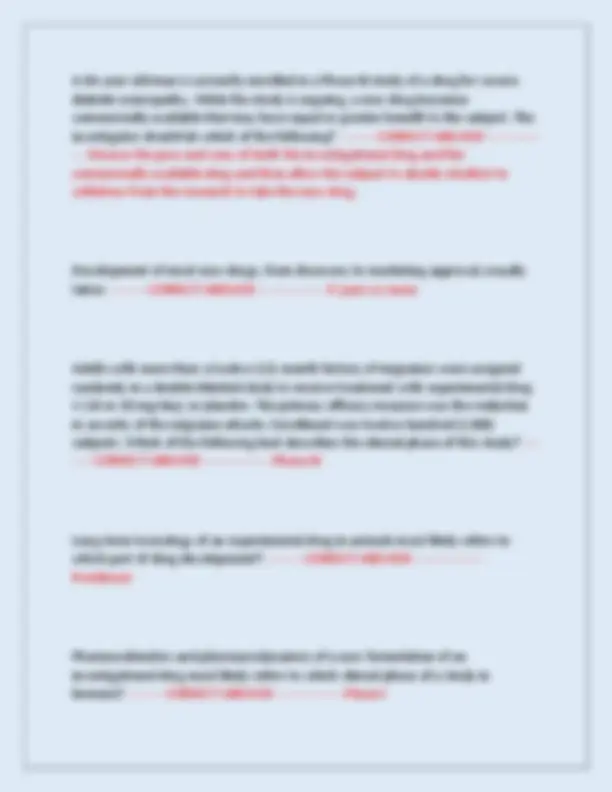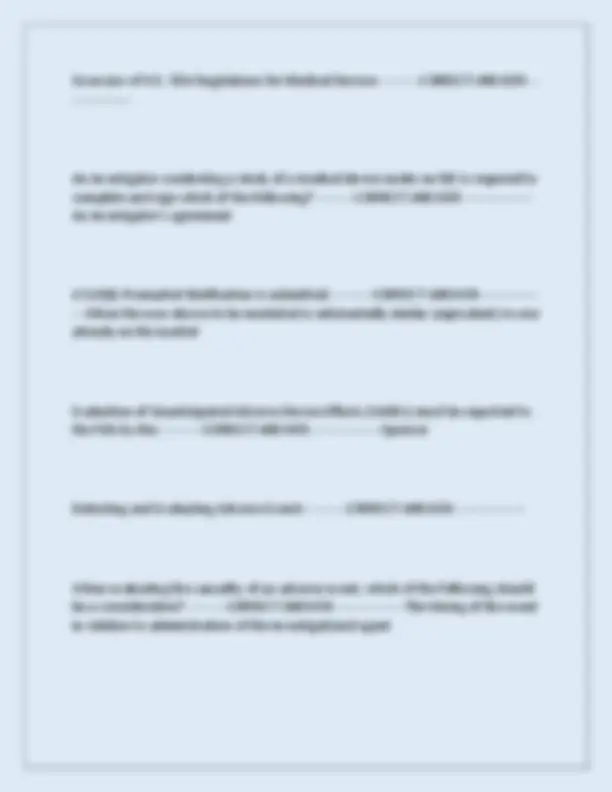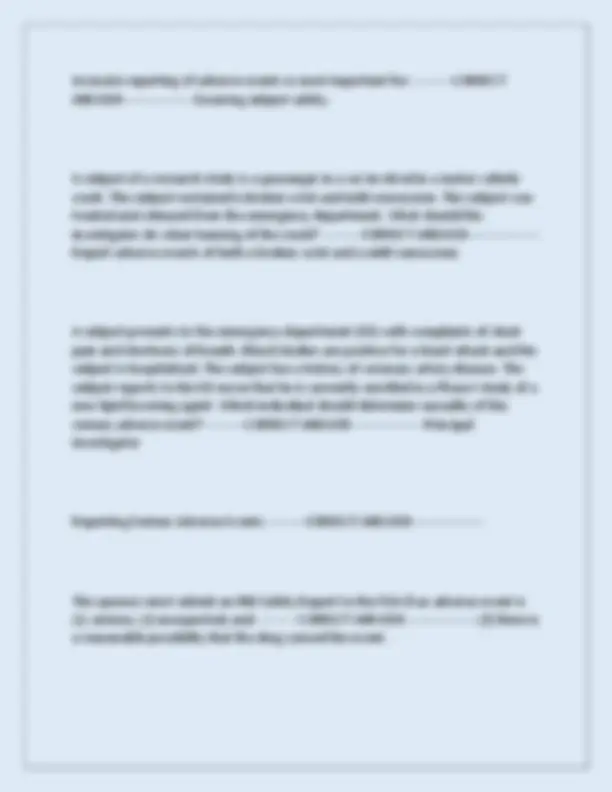








Study with the several resources on Docsity

Earn points by helping other students or get them with a premium plan


Prepare for your exams
Study with the several resources on Docsity

Earn points to download
Earn points by helping other students or get them with a premium plan
Community
Ask the community for help and clear up your study doubts
Discover the best universities in your country according to Docsity users
Free resources
Download our free guides on studying techniques, anxiety management strategies, and thesis advice from Docsity tutors
This comprehensive document provides an in-depth overview of the CITI Training for Good Clinical Practice (GCP) Exam, complete with all questions and verified answers, ensuring a top-grade performance. The latest version for 2025 has been meticulously compiled to aid students and professionals in mastering the principles of GCP as mandated by international guidelines like ICH E6, FDA, and HHS. Key highlights include insights into informed consent processes, emphasizing the importance of explaining trial arm probability without specific presentation guidelines. It underscores the broader confidentiality requirements of ICH E6 compared to FDA or HHS, stressing the necessity of informing subjects about third-party access to medical records. The document explains FDA regulations on consent form copies and discusses the new ICH E6(R2) addendum, which mandates a risk-based quality management system throughout trial stages.
Typology: Exams
1 / 12

This page cannot be seen from the preview
Don't miss anything!







In terms of explaining the probability of assignment to trial arms in consent forms, which is true? ---------CORRECT ANSWER-----------------ICH notes that it should be included, but does not specify how the information should be presented. ICH E6 has broader requirements than FDA or HHS concerning confidentiality of medical records and access by third parties. If investigators are complying with ICH E6 guideline, they must: ---------CORRECT ANSWER-----------------Clearly disclose to subjects in the informed consent form that the monitor, auditor, IRB/IEC, and the regulatory authorities may have access to the subject's medical records Regarding subject receipt of a signed and dated copy of the consent forms, which is true about FDA regulations? ---------CORRECT ANSWER-----------------The FDA regulations allow subjects or the legally acceptable representatives (LARs) to receive either a signed or unsigned copy. The new ICH E6(R2) integrated addendum requires sponsors to implement systems to manage quality throughout all stages of the trial process. The system should use a risk-based approach including which of the following? ---------
CORRECT ANSWER-----------------Identification of study risks to determine which may safely be omitted from continual monitoring. When the sponsor-investigator holds the IND for an investigational drug he or she is responsible for annual reporting of which one of the following to FDA? --------- CORRECT ANSWER-----------------IND report Who is responsible for making the initial risk determination for a device being used in a study? ---------CORRECT ANSWER-----------------The sponsor-investigator. Which of the following is an acceptable criterion for determining that a study of an approved drug does not require an IND? ---------CORRECT ANSWER----------------- The study is not intended to be reported to FDA to support a new indication or support a labeling change. An investigator is confronted with a life-threatening situation that necessitates using a test article in a human subject who is unable to provide informed consent and there is no time to obtain consent for the individual's legal representative. Under the FDA regulations, which of the following describes the best course of action for the investigator: ---------CORRECT ANSWER-----------------The investigator and another physician not part of the study team agree that the situation necessitates the use of the test article and the IRB will be notified later.
For a Phase I new drug study in humans, what is the primary source of the data included in the initial Investigator's Brochure? ---------CORRECT ANSWER------------- ----Preclinical data A primary purpose of the ICH is to: ---------CORRECT ANSWER----------------- Minimize the need for redundant research. The ICH GCP guidelines: ---------CORRECT ANSWER-----------------Set standards for the design, conduct, monitoring and reporting of clinical research. ICH E6 describes standards that apply to: ---------CORRECT ANSWER----------------- Investigators, sponsors, and IRBs In the United States, following the ICH E6 guideline is: ---------CORRECT ANSWER--- --------------Voluntary for FDA-regulated drug studies. Which of the following are the three principles included in the Belmont Report? -- -------CORRECT ANSWER-----------------Respect for Persons, Beneficence, Justice.
Which of the following is an example of how the Principle of Beneficence can be applied to a study employing human subjects? ---------CORRECT ANSWER------------- ----Determining that the study has maximized benefits and minimized risks. Which of the following best describes the principle of Respect for Persons as described in the Belmont Report? ---------CORRECT ANSWER----------------- Information, comprehension, voluntariness. When must the investigator update the IRB about the progress of a trial? --------- CORRECT ANSWER-----------------During the conduct of the study and at termination Form FDA 1572, Statement of Investigator, is legally binding between the investigator and the: ---------CORRECT ANSWER-----------------FDA The investigator must report adverse events to the: ---------CORRECT ANSWER------ -----------Sponser In completing Form FDA 1572, Statement of Investigator, the investigator agrees to ---------CORRECT ANSWER-----------------Conduct or supervise the investigation personally
Managing Investigational Agents According to GCP Requirements ---------CORRECT ANSWER----------------- Which of the following is an important component of drug accountability? --------- CORRECT ANSWER-----------------Drug shipping and disposition records Who is ultimately responsible for product accountability at the study site? --------- CORRECT ANSWER-----------------Investigator Investigational product dispensing or administration information for the sponsor is recorded on the: ---------CORRECT ANSWER-----------------Case report form The packaging of investigational drugs should ideally: ---------CORRECT ANSWER---- -------------Be designed to help with subject compliance Where is information on storage requirements for the investigational product usually found? ---------CORRECT ANSWER-----------------In the study protocol
An investigator conducting a study of a medical device under an IDE is required to complete and sign which of the following? ---------CORRECT ANSWER----------------- An investigator's agreement A 510(k) Premarket Notification is submitted: ---------CORRECT ANSWER-------------- ---When the new device to be marketed is substantially similar (equivalent) to one already on the market Evaluation of Unanticipated Adverse Device Effects (UADEs) must be reported to the FDA by the: ---------CORRECT ANSWER-----------------Sponsor Detecting and Evaluating Adverse Events ---------CORRECT ANSWER----------------- When evaluating the causality of an adverse event, which of the following should be a consideration? ---------CORRECT ANSWER-----------------The timing of the event in relation to administration of the investigational agent
A double-blinded trial for a new indication is conducted under an IND comparing two (2) marketed drugs, at twice the approved prescribed doses. On Day 2, subject 603 had difficulty breathing. Although it was life-threatening initially, subject 603 was treated and discharged directly from the emergency department after complete recovery. On Day 5, subject 20 had a headache, which led to hospitalization and required blood pressure lowering medications. These episodes cannot be explained on the basis of the pharmacological property of either drug or the subjects' medical histories. The investigator would submit an SAE report for: ---------CORRECT ANSWER-----------------Both of the subjects During the course of administration of an investigational drug, the following events occurred: On Day 7, subject 603 had an unexpected stroke that requires hospitalization; On Day 15, subject 415 complained of nausea, vomiting, and headache relieved by aspirin; On Day 21, subject 20 has brief dizzy spells upon trying to stand. Which of these subject's events meets the FDA definition of "serious" and "unexpected" and would require the sponsor to file an IND Safety Report with the FDA? ---------CORRECT ANSWER-----------------Subject 603 only Subject 311 has had elevated white blood cell (WBC) counts for the past two (2) study visits, with no clinical signs or symptoms. "Increased WBC count" is not listed in the Investigator's Brochure (IB) as an adverse event. The investigator should: ---------CORRECT ANSWER-----------------Report the elevated WBC to the sponsor as an unexpected adverse event Audits and Inspections of Clinical Trials ---------CORRECT ANSWER-----------------
When the FDA conducts an inspection, the inspectors will: ---------CORRECT ANSWER-----------------Review regulatory records. According to ICH E6, an "audit" is defined as: ---------CORRECT ANSWER--------------- --A systematic and independent examination of trial-related activities and documents. OHRP is an oversight body primarily concerned with: ---------CORRECT ANSWER---- -------------Protection of human research subjects The overall goal of monitoring, audits, and inspection activities is to: --------- CORRECT ANSWER-----------------Ensure the protection of human research subjects and data integrity. According to ICH E6, an inspection is defined a ---------CORRECT ANSWER------------- ----An official review of documents, facilities, records, and any other resources related to a clinical trial. Monitoring of Clinical Trials by Industry Sponsors ---------CORRECT ANSWER---------